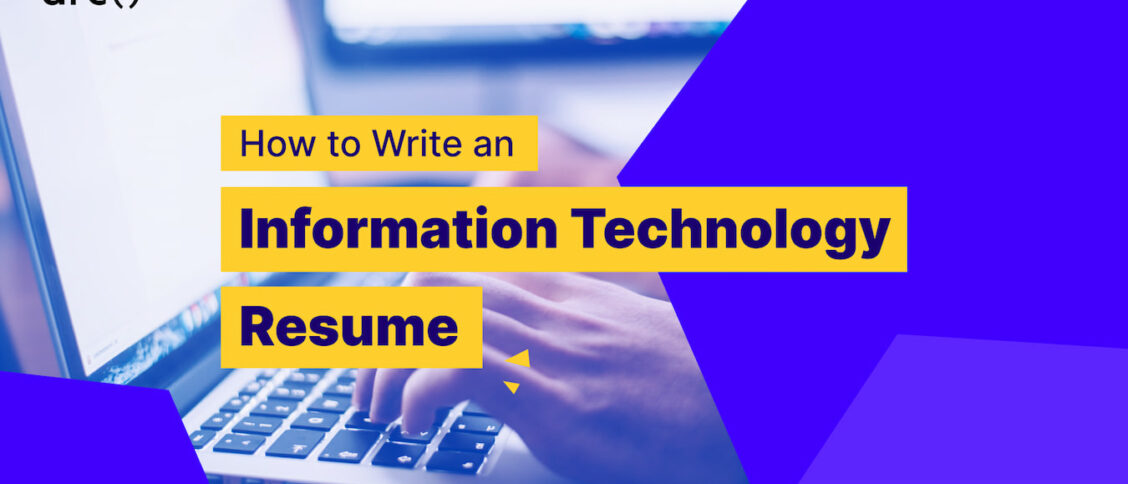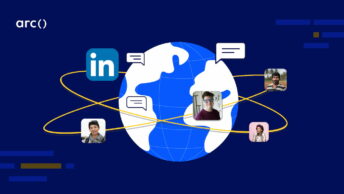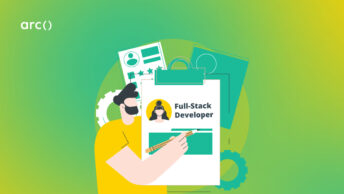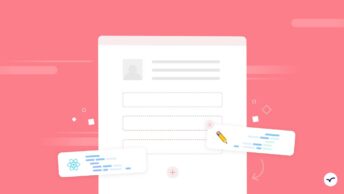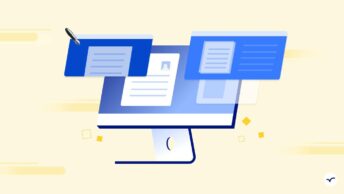Looking to get a job in information technology?
The IT sector encompass a wide variety of job titles, including analysts, coordinators, security researchers, cloud architects, systems managers, support technicians, network administrators, telecommunications specialists, and more.
But, they all have one thing in common: you need to know how to write a great IT resume if you want the best chance at landing that interview!
So, whether you’re an entry-level IT specialist, senior network engineer, or head of IT, this is the guide for you. Just below is a sample information technology resume to use as a reference. After that, we go down the line from the top of the resume to the bottom explaining how to write it right. Then, we end with some expert tips to make sure you have a head start when applying!
Ready to get started?
Looking to hire the best remote developers? Arc can help you:
⚡️ Get instant candidate matches without searching
⚡️ Identify top applicants from our network of 350,000+
⚡️ Hire 4x faster with vetted candidates (qualified and interview-ready)
Try Arc to hire top developers now →
Sample IT Resume (for Reference)
Aaron T. Birchall
8418 Arcadia Drive, Portland, OR 97233
+1 (202) 555 0110
birchall.aaron@hotmail.com
linkedin.com/in/aaronbirchall
abirchallportfolio.com
Summary Statement
I am a mathematics graduate with six years of experience working in a top Oregon accounting firm. My key achievements include increasing monthly recurring revenue by 46% over the past 2 years and reducing budget variance by 37%. Having self-educated experience in SQL querying, Active Directory, and various server management platforms, I am now eager to carve out a career as the new IT Analyst, Level 1 at Gemini Informatics that builds on my quantitative, technical, and analytical skills.
Work History
Accountant
Friendly Oregon Accounting Firm, Portland, OR
October 2015 – Present
Key Responsibilities & Achievements:
- Collaborated with different departments and executives on requisitions and budgets, leading to a 37% reduction in budget variance.
- Spearheaded project organizing, sourcing, and integrating new software packages, resulting in a 46% increase in monthly recurring revenue in just 2 years.
- Implemented a diverse range of algorithms and SQL queries to convert real-life problems into working code.
- Analyzed previous budgets, evaluating micro and macro environments, forecasting new budgets, and keeping budgets on track.
Financial Analyst Intern
KAQP Corporation, Eugene, OR
July 2015 – October 2015
Key Responsibilities & Achievements:
- Analyzed funding, income, and expenditure of different departments following the correct documentation processes and financial practices.
- Created an app similar to QuickBooks from scratch to help clients with their accounting needs.
- Gained hands-on familiarity with object-oriented programming and writing internal applications from scratch.
Education
Bachelor of Science (BS) in Mathematics
Oregon State University, Corvallis, OR
September 2012 – June 2015
Related Coursework: Structured Programming, Algorithms & Applications, Analytical & Computational Foundations, Problem Solving Methods.
Key Skills
- SQL queries
- GRC software controls & audits
- JIRA/Azure DevOps
- Compliance activities (SOC 1, SOC 2, PCI-DSS, ISO 27001, SOX 404, and others)
- Problem-solving skills
- Analytical skills
- Customer service & support skills
- Organizational skills
Certifications
Computational Thinking Using Python Certificate, MIT, 2019.
Read More: Important Mistakes to Avoid at Your Next Remote Interview

Arc is the best place to find great remote jobs. Find great remote jobs at top startups and tech companies. Freelance and full-time remote opportunities are available.
Sign up here
How to Write an IT Resume
Information technology (IT) is a diverse and rewarding field to work in. Whether you’re a seasoned IT professional or just looking for a new challenge, there is a wealth of opportunities available in this growth industry.
However, it’s also a highly competitive sector. To maximize your chances of securing a job, it’s essential to have an outstanding IT resume. In this guide, we’ll go through all the steps you must take to accomplish this.
Let’s follow the story of Aaron Birchall as he prepares his resume for his journey into a new IT role.
Aaron received a bachelor’s degree in mathematics from Oregon State University in 2015. Since then, he’s been working as an accountant and has built his programming skills on the side. He’s now keen to find employment in his real passion: information technology. His efforts to find his dream job will help us better understand how to write a quality resume for IT jobs.
1. Before writing your IT resume…
An essential first step in writing an IT specialist resume is doing some preparation. To begin with, consider which resume format will best communicate your tech skills and abilities. The two main resume formats are the reverse-chronological structure and the functional structure (a skills-based format).
The reverse-chronological resume template is ideal for people who can demonstrate a strong track record of relevant work experience. This format involves detailing your work history, starting with your most recent position, and working back from there.
Conversely, a functional structure can precisely match your abilities to the requirements of the role you’re applying for. This makes it a practical method for when you’ve made a career change or have gaps in your work history.
Since Aaron is moving into a new career industry (from accounting), he would opt for the functional format. It allows him to highlight precisely how the skills he has gained during his education and real-world experience apply to the role he is seeking in IT. Given that he has little direct experience in IT employment, this is a practical option for him.
Once you’ve decided on the format that best suits your situation, you should tailor your resume to the specific role you’re pursuing. To do this, carefully read through the job description to find relevant keywords for inclusion in your IT specialist or IT project manager resume.
After taking care of those critical factors, it’s also good practice to ensure that your IT resume contains sufficient white space (meaning, don’t fill up every inch of the document with text!). This will make it easier for the recruiter or hiring manager to read, thereby increasing your chances of getting an interview.
2. Contact details
It helps to begin your IT technician resume with a section detailing your contact information. Start with your full name. Following this, you can write a branding statement or add your professional title if you feel it strengthens your application.
Include your address if you’re applying for a location-relevant job. Adding your working time zone is helpful if you’re going for a remote position. After this comes your mobile number, including your country code, and then your email address.
Keep your email address professional using some appropriate combination of your first and last names. Avoid nicknames and childish-looking addresses like unicornprincess246@yahoo.com at all costs.
Lastly, include links to any social media profiles, professional websites, or online portfolios you may have which are relevant to the application. Never include sensitive data in your application, such as your birthday or SSN. and, don’t reference any religious or political affiliations, as they have no place on your resume.
Aaron’s information technology resume provides a useful example to follow:
Aaron T. Birchall
8418 Arcadia Drive, Portland, OR 97233
+1 (202) 555 0110
birchall.aaron@hotmail.com
linkedin.com/in/aaronbirchall
abirchallportfolio.com
3. Introductory paragraph / summary statement
Your next step in building an excellent resume for IT jobs is crafting an attention-grabbing introductory statement. Research has found that, on average, recruiters only spend a few seconds reading resumes. Failure to make an impact here increases the likelihood of your resume failing to reach the interview stage.
The summary statement should go at the top of the document. It needs to be both impactful and short, similar to a LinkedIn summary (about section). As a result, you should summarize all the key points in three to five sentences — only including the most relevant elements from your background.
Here you should start tailoring your resume to the role, using relevant keywords you found during your preparation.
An effective way of adding weight to your resume is to use numbers as evidence of specific achievements. So rather than stating “I boosted sales,” specify “I increased sales by 39%”.
Aaron’s example IT resume opening statement sparks interest in just a few short sentences:
Summary Statement I am a mathematics graduate with six years of experience working in a top Oregon accounting firm. My key achievements include increasing monthly recurring revenue by 46% over the past 2 years and reducing budget variance by 37%. Having self-educated experience in SQL querying, Active Directory, and various server management platforms, I am now eager to carve out a career as the new IT Analyst, Level 1 at Gemini Informatics that builds on my quantitative, technical, and analytical skills.
In today’s digital age, ensuring the originality of your content is crucial; using an AI checker can help maintain the integrity of your resume.
4. Key skills
Having piqued the hiring manager’s interest with an excellent summary statement, you subsequently need to demonstrate how your IT skills make you the ideal candidate effectively.
But, don’t just blindly add keywords from a predetermined list. Tailor your resume to the position in question by searching the IT job description for important skills they’re looking for in a candidate.
Revisit the job description and person specification to understand the types of skills the employer is looking for. From there, pick four or five related skills you can support using your prior experiences.
List each primary skill and your best coding languages with relevant bullet points underneath demonstrating how you put the skill into practice. You can also use a combination of hard and soft skills where applicable. IT hiring managers are always keen to find people who have abilities like leadership and business knowledge.
Have a look at Aaron’s entry-level IT resume sample for guidance:
Key Skills
- SQL queries
- GRC software controls & audits
- JIRA/Azure DevOps
- Compliance activities (SOC 1, SOC 2, PCI-DSS, ISO 27001, SOX 404, and others)
- Problem solving skills
- Analytical skills
- Customer service & support skills
- Organizational skills
Read More: How to List Coding Languages on a Resume
5. Work experience
After the information technology resume skills section comes the work experience, at least it does for Aaron. Start your work experience section with your most recent role, detailing each earlier position in order after that.
Every item in your list should begin with your job title, followed by the company’s name, the location, and the dates of your employment. After that, give a few bullet points with key accomplishments using as many numbers as possible to illustrate how effective you were at accomplishing your responsibilities.
Take a look at Aaron’s career change IT resume examples below:
Work History
Accountant
Friendly Oregon Accounting Firm, Portland, OR
October 2015 – Present
Key Responsibilities & Achievements:
- Collaborated with different departments and executives on requisitions and budgets, leading to a 37% reduction in budget variance.
- Spearheaded project organizing, sourcing, and integrating new software packages, resulting in a 46% increase in monthly recurring revenue in just 2 years.
- Implemented a diverse range of algorithms and SQL queries to convert real-life problems into working code.
- Analyzed previous budgets, evaluating micro and macro environments, forecasting new budgets, and keeping budgets on track.
Financial Analyst Intern
KAQP Corporation, Eugene, OR
July 2015 – October 2015
Key Responsibilities & Achievements:
- Analyzed funding, income, and expenditure of different departments following the correct documentation processes and financial practices.
- Created an app similar to QuickBooks from scratch to help clients with their accounting needs.
- Gained hands-on familiarity with object-oriented programming and writing internal applications from scratch.
6. Academic history
The following section of your IT CV needs to communicate your vital academic accomplishments.
Start with the degree, diploma, or certificate earned (or in progress). After that, include the name of the educational institution and the dates you were there. Then list all the coursework that pertains to the role you’re applying for.
If you have an excellent GPA, then you might want to include this. However, this is not necessary, and not recommended if it’s much less than perfect. Place your GPA in parenthesis after the Latin honors if you achieved these, otherwise write them after your major.
Aaron’s example below may serve as a helpful guide to writing your own:
Education
Bachelor of Science (BS) in Mathematics
Oregon State University, Corvallis, OR
September 2012 – June 2015
Related Coursework: Structured Programming, Algorithms & Applications, Analytical & Computational Foundations, Problem Solving Methods.
You can still include your degree if you haven’t yet finished it. Simply write your start date as normal, followed by your expected completion date. For instance:
September 2021 – June 2025 (expected date of completion)
If you haven’t completed (or started) a college degree, include your high school diploma using the same format.
See this tech resume example:
Education
High School Diploma
Washington High School, Grosse Pointe, MI
September 2008 – June 2012
Relevant Extracurricular Activities: Chair of The Programmers Society, 2011 – 2012. Arranged and chaired regular society meetings, organized the 2012 annual conference, and ran programming workshops.
7. Certifications
Tech employers are often as impressed with proper certifications as they are with college degrees. Should you have earned any, make sure you list them clearly. Examples of certificates include:
- Cybersecurity Administration Certificate offered by Syracuse University
- Computer Science – Information Systems Certification offered by Columbia University
- Professional Certificate in Computer Science for Artificial Intelligence offered by Harvard University
- Computational Thinking using Python offered by MIT
- Java SE 8 OCA Certification provided by Oracle
To include these in your resume, place the certificate/course name first. Follow this with the awarding organization and then the year you earned it. For example:
Certifications
Computational Thinking Using Python Certificate, MIT, 2019.
8. Other resume sections
You can also add additional value to your IT resume with other sections that highlight your skills and accomplishments. Consider the following examples:
Organization Memberships
Membership of relevant professional organizations can demonstrate your commitment to and involvement in the field. If you’re a member of groups like the Society for Information Management or User Experience Professionals Association, state this.
Volunteer Work
Experience in volunteer work can be very impressive to potential employees. It can highlight additional skills you’ve developed while also demonstrating that you’re a compassionate person.
(Human) Languages
Language skills are highly desirable to most employers. If you have these, include them prominently on your resume.
Hobbies & Interests
Mentioning hobbies and interests is another way of demonstrating additional skills to hiring managers. If you have relevant interests, such as building PCs and developing apps, mention them and explain how they relate to the position.
IT Projects on a Resume
Adding any tech projects that you’re contributing to can be highly beneficial. If these have their own project profiles online, then it might be more impactful to provide links. It enables you to present the full scale of your projects while also saving room on your resume.
Read More: Top Behavioral Interview Questions and How to Answer Them
Great IT Resume Tips to Remember
1. Choose a relevant resume format
Determine whether you’ll need to use a reverse-chronological format or a functional (skills-based) format for your resume. The reverse chronological resume is the most common format, but you can use a functional resume if you’re looking to make a career switch like Aaron. This better highlights your skills and achievements in relation to relevant job vacancies.
2. Write for human readers, but remember the bots
Always write your resume for a human reviewer. But, keep in mind that many companies use an applicant tracking system (ATS) to help their backlogged HR teams manage the hiring process and the hundreds of job candidates applying. Not to mention sorting through the IT analyst, IT coordinator, systems architect, network engineer, and countless other IT job titles they may be looking to fill!
The ATS bot initially collects all the job seeker’s information from their IT resumes and cover letters. Then, it begins the comparison process of each candidate against all other candidates who’ve applied, as well as each candidate against the job description.
Factoring this process in when writing will help you get past the ATS stage and get consideration for a sit-down interview after the human review. To do that, you want to be a match to the job description but unmatched when it comes to ranking you against the other candidates.
3. Put yourself in their shoes when writing
We’ve already stressed the importance of tailoring the resume to the application. To help do that, try looking at it through the eyes of the IT recruiter or hiring manager. Is the most important information as close to the beginning (top) of the tech resume as possible? Does all the content in the CV strengthen the application and the candidate’s (your) chances? Is everything relevant to the IT job description?
Make sure your answer to each of those questions is a definite yes!
4. Provide concrete examples of soft skills
How to show you have great communication skills? What can you do to portray your knack for organization, collaboration, critical thinking, or problem solving?
When explaining your soft skills, give strong examples of where you’ve used these to good effect. For instance, show how your leadership skills or critical thinking skills resulted in beneficial outcomes for your company or society. Numbers always help!
5. Brevity is key
Aim to write a crisp, concise, and impactful resume. A one-page resume is ideal for entry-level IT professionals and junior IT specialists, while a two-page resume is better for those with more experience, such as mid-level, senior, and executive-level information technology professionals.
Three pages is always too much!
6. Strategically incorporate design & color elements
Incorporate basic design elements and eye-pleasing color combinations (without going overboard) to add some personality into your resume for tech careers.
7. Include an information technology cover letter, too!
During our Remote Career Summit back in 2020, we had two very special guests for an episode on writing and remote work: Tammy Bjelland, the founder and CEO of Workplaceless, and David Heinemeier Hansson (the Notorious DHH), cofounder of Basecamp & HEY and creator of the popular Ruby on Rails web development framework.
In that episode, David told us, “You submit your CV and your cover letter, and we don’t even look at your CV until we’ve been captured by your cover letter.” He advises job seekers to study the tone of the organization they’re trying to join, and try to emulate that tone in your cover letter.
So, as you can see, IT cover letters are a crucial part of your job application! To make that easier on you, check out our guide on how to write a cover letter for IT jobs. Or, see this guide on how to write a cover letter for software engineering jobs.
The Keys To Writing An Information Technology Resume
We hope you’ve found this guide helpful and are now able to put an exceptional IT resume together. As always, if you have any questions, feedback, or just want to share your experiences applying for jobs in IT, leave us a comment below!
To see resume guides for similar industries and tech stacks, check these out:
- How to Write a CS Resume for Computer Science Jobs
- How to Write a Software Development Resume
- How to Write a Web Developer Resume Sure to Impress the Hiring Manager
- Resume Formatting Tips for Senior Software Engineers
Thanks for reading, and good luck on your next IT job application!
You can also explore HireAI to skip the line and:
⚡️ Get instant candidate matches without searching
⚡️ Identify top applicants from our network of 350,000+ with no manual screening
⚡️ Hire 4x faster with vetted candidates (qualified and interview-ready)


